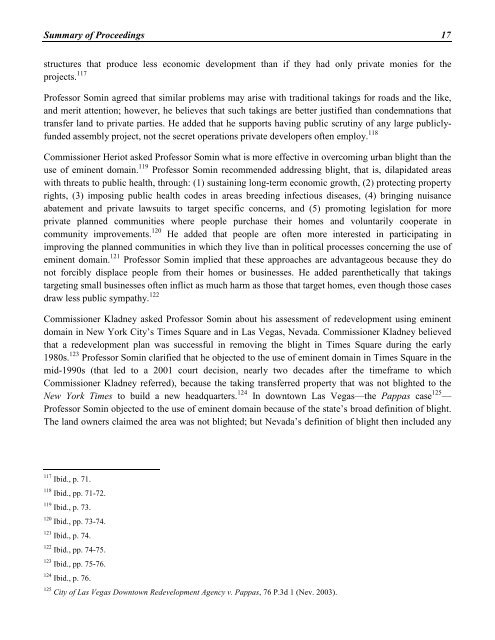Create successful ePaper yourself
Turn your PDF publications into a flip-book with our unique Google optimized e-Paper software.
Summary of Proceedings 17structures that produce less economic development than if they had only private monies for theprojects. 117Professor Somin agreed that similar problems may arise with traditional takings for roads and the like,and merit attention; however, he believes that such takings are better justified than condemnations thattransfer land to private parties. He added that he supports having public scrutiny of any large publiclyfundedassembly project, not the secret operations private developers often employ. 118Commissioner Heriot asked Professor Somin what is more effective in overcoming urban blight than theuse of eminent domain. 119 Professor Somin recommended addressing blight, that is, dilapidated areaswith threats to public health, through: (1) sustaining long-term economic growth, (2) protecting propertyrights, (3) imposing public health codes in areas breeding infectious diseases, (4) bringing nuisanceabatement and private lawsuits to target specific concerns, and (5) promoting legislation for moreprivate planned communities where people purchase their homes and voluntarily cooperate incommunity improvements. 120 He added that people are often more interested in participating inimproving the planned communities in which they live than in political processes concerning the use ofeminent domain. 121 Professor Somin implied that these approaches are advantageous because they donot forcibly displace people from their homes or businesses. He added parenthetically that takingstargeting small businesses often inflict as much harm as those that target homes, even though those casesdraw less public sympathy. 122Commissioner Kladney asked Professor Somin about his assessment of redevelopment using eminentdomain in New York City’s Times Square and in Las Vegas, Nevada. Commissioner Kladney believedthat a redevelopment plan was successful in removing the blight in Times Square during the early1980s. 123 Professor Somin clarified that he objected to the use of eminent domain in Times Square in themid-1990s (that led to a 2001 court decision, nearly two decades after the timeframe to whichCommissioner Kladney referred), because the taking transferred property that was not blighted to theNew York Times to build a new headquarters. 124 In downtown Las Vegas—the Pappas case 125 —Professor Somin objected to the use of eminent domain because of the state’s broad definition of blight.The land owners claimed the area was not blighted; but Nevada’s definition of blight then included any117 Ibid., p. 71.118 Ibid., pp. 71-72.119 Ibid., p. 73.120 Ibid., pp. 73-74.121 Ibid., p. 74.122 Ibid., pp. 74-75.123 Ibid., pp. 75-76.124 Ibid., p. 76.125 City of Las Vegas Downtown Redevelopment Agency v. Pappas, 76 P.3d 1 (Nev. 2003).


